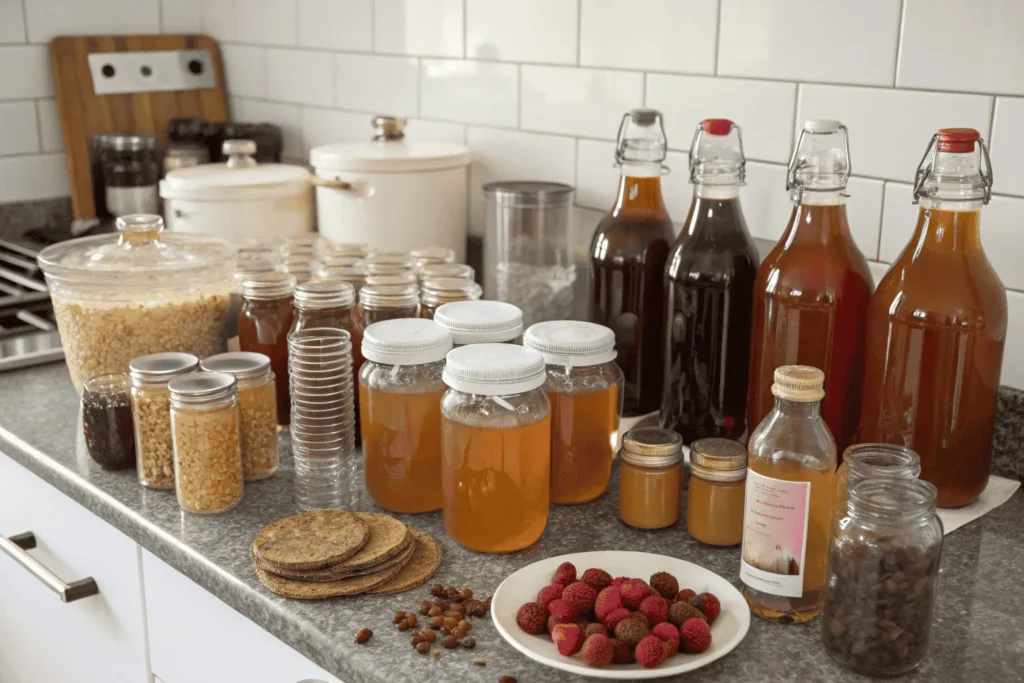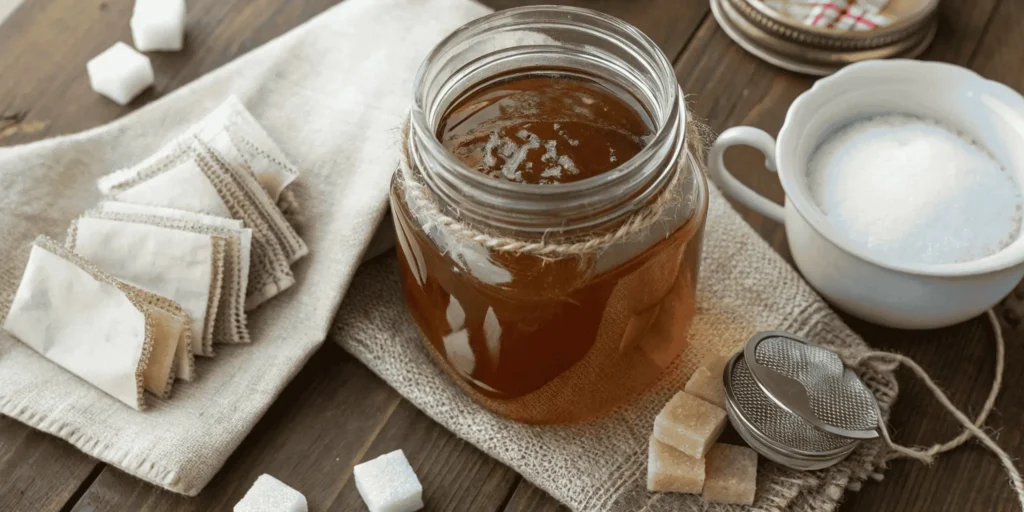Discover a straightforward kombucha recipe perfect for beginners. Brew your own tangy, fizzy drink easily with this step-by-step guide.
Understanding the Kombucha Recipe Basics
A kombucha recipe is surprisingly simple. It involves just a few items and some patience. The key is understanding how fermentation works. Therefore, let’s explore the basic elements of making kombucha. If you’re a fan of DIY beverages, you might also enjoy exploring other healthy cinnamon roll recipes for pairing.
Key Components of a Kombucha Recipe
The main parts of any kombucha recipe include sweet tea, a SCOBY, and starter liquid. The SCOBY, or symbiotic culture of bacteria and yeast, ferments the tea. The starter liquid helps to ensure the process begins correctly. Consequently, these items create the tangy kombucha taste.
Basic Kombucha Recipe Items
To start, you need water, sugar, tea bags or loose-leaf tea, a SCOBY, and starter liquid. You will also need a glass jar and a cloth cover. Additionally, you will need bottles for the second ferment. These items will help make your kombucha recipe successful.
Equipment Needed for a Kombucha Recipe
Before starting your kombucha recipe, gather your equipment:
- A large glass jar
- A breathable cloth cover and rubber band
- Bottles for flavoring and storing the kombucha
- A pot for brewing tea
This preparation ensures you’re ready for the fermentation process. If you’re interested in learning about using different ingredients, explore our squash and kidney beans recipe for ideas on combining unusual flavors.
Easy Step-by-Step Kombucha Recipe Guide
This kombucha recipe is designed for beginners. Follow each step closely. This ensures a successful and tasty outcome. Therefore, let’s dive into the step-by-step process.
Step 1: Brewing the Sweet Tea Base
First, boil the water. Next, add the sugar, and stir until it dissolves completely. Afterward, add your tea. Let it sit for 10-15 minutes. Then, remove the tea. Allow the sweet tea to cool to room temperature. Consequently, this is the base for your kombucha recipe.
Step 2: Preparing the Fermentation Jar
Pour the cooled sweet tea into your clean glass jar. Next, add the SCOBY and the starter liquid. These are key to starting the fermentation. The starter liquid helps create the right environment. Therefore, this step is very important.
Step 3: The Primary Fermentation
Cover the jar with a cloth, securing it with a rubber band. This allows air to flow in, but keeps out any unwanted items. Place it in a dark, room-temperature area. Let the kombucha ferment for 7 to 30 days. The time will vary depending on the temperature and how tangy you like it. Thus, patience is key in this kombucha recipe.
Step 4: Second Fermentation for Flavor
Once the kombucha is to your liking, you can move it to bottles for the second ferment. Add your choice of flavors, such as fruit, ginger, or herbs. Seal the bottles tightly and let them sit at room temperature for 1 to 3 days. Be sure to “burp” the bottles daily to prevent pressure buildup. Therefore, this second ferment adds flavor and fizz.
Step 5: Refrigerating and Enjoying
After the second fermentation, put the kombucha in the fridge. This will slow down the fermentation. Then, you can enjoy your homemade kombucha. Serve it chilled. It tastes good with meals or as a refreshing drink anytime. Therefore, you can finally enjoy your creation.

Flavor Variations for Your Kombucha Recipe
One of the great things about kombucha is its flexibility. You can add a variety of flavors. Accordingly, experiment to find your favorites. Therefore, let’s look at some flavor ideas.
Fruit Variations
Adding fruit is a popular way to flavor your kombucha. Berries, such as raspberries or blueberries, work well. Also, try using slices of citrus. Furthermore, you can use mashed fruit or fruit juice. Hence, fruit adds both flavor and sweetness.
Herb and Spice Variations
Herbs and spices can create unique kombucha flavors. Ginger and mint are popular choices. You can use them fresh or dried. Also, try cinnamon or cloves for a spicy note. Therefore, these provide a sophisticated flavor profile.
Creative Flavor Blends
Do not hesitate to get creative with flavors. Combine fruits with herbs. For example, try strawberry and basil. You can also pair ginger with lemon. The options are endless. Therefore, have fun and explore unique tastes.
Tips for a Successful Kombucha Recipe
Following these tips can help ensure your kombucha recipe is a success. These guidelines will help you avoid common mistakes. Moreover, they ensure a healthy and tasty brew. Therefore, let’s look at some tips.
Using Quality Items
Start with good tea and filtered water. These have a great impact on taste. Also, make sure your SCOBY is healthy. Therefore, quality items help create great kombucha.
Maintaining Cleanliness
Cleanliness is key for kombucha brewing. Wash all your equipment before use. This prevents mold. Moreover, this helps protect your culture. Thus, cleanliness is very important for a safe brew.
Monitoring Fermentation
Keep an eye on your kombucha during fermentation. Taste it regularly. This helps you find the right balance of sweetness and tanginess. Also, make adjustments as needed. Therefore, watching the kombucha helps customize the taste.
Avoiding Metal Utensils
It is better to avoid using metal items with kombucha. Metal can react with the acidity. Instead, use wood or plastic. Also, glass is safe to use. Therefore, this will maintain the integrity of your kombucha.
Troubleshooting Common Kombucha Recipe Issues
Sometimes, things go wrong. Knowing how to fix problems is essential. Therefore, let’s explore common issues. Also, we will look at ways to address these problems.
Mold Growth Concerns
If you see mold, you should throw out the batch. Mold usually appears as fuzzy spots. Black or green mold is especially dangerous. Thus, throw out the entire batch if you see mold.
Weak or Inactive SCOBY Issues
A weak SCOBY can slow fermentation. It might also not produce kombucha correctly. If you have a weak SCOBY, get a new one or try a new batch using more starter liquid. Therefore, a healthy SCOBY is crucial.
Off Flavors and Odors
If your kombucha has an unusual smell or flavor, this can be an issue. This might indicate a problem with sanitation. It might also mean the fermentation is off. If this occurs, start with a fresh SCOBY and fresh ingredients. Thus, a fresh batch may solve many problems.
The Benefits of Making Your Own Kombucha
Making kombucha at home has many upsides. It is a fun project. It also allows you to customize flavors. Therefore, let’s examine these benefits further.
Cost Savings
Making your kombucha is less costly than buying it. The cost of SCOBY is minimal. After that, you will need just tea, water, and sugar. Therefore, brewing at home saves you money.
Customizable Flavors
When you make kombucha, you control the flavors. You can use a variety of fruits, herbs, and spices. This allows you to make something you love. Consequently, you can fully customize it to your liking.
Control Over Items
When brewing at home, you know all the items used. There are no hidden additives. Furthermore, you will avoid artificial preservatives. Hence, you will have a healthier drink.

Kombucha Recipe: Conclusion
Making kombucha at home is easy and fun. This kombucha recipe is perfect for anyone. Start brewing today and enjoy a delicious, healthy drink. In conclusion, brewing kombucha will be a satisfying endeavor.
Frequently Asked Questions (FAQs)
What is the best tea to use in a kombucha recipe?
Black and green teas are best for making kombucha. These teas have the right items for fermentation. Avoid teas with oils or flavors. Furthermore, using pure tea will produce the best results. Therefore, start with a good quality tea.
How long does it take to make kombucha?
The first fermentation takes 7 to 30 days. The time is affected by room temperature. Warmer temps will ferment faster. Also, cooler temps will slow the fermentation down. The second ferment takes 1 to 3 days. Thus, patience is necessary for the entire process.
How do I know when my kombucha is ready?
You will know your kombucha is ready when it tastes tart. It should have a slight vinegar-like flavor. It should also be less sweet. The time will depend on the temperature and your taste. Therefore, tasting it regularly will tell you when it’s done.
Can I use honey instead of sugar?
It is not recommended to use honey in a kombucha recipe. Honey has natural items that can change the fermentation process. Also, honey can cause unwanted flavors. Therefore, stick to using regular white sugar for best results.

